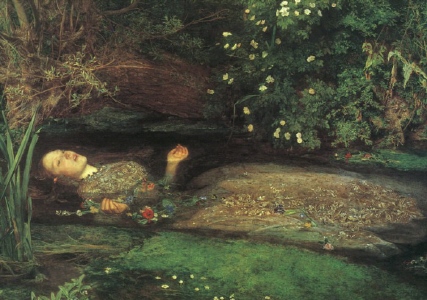

In 1848, Dante Gabriel Rossetti together with Edward Burne Jones, George Frederic Watts and William Morris, founded the Pre-Raphaelite Brotherhood in England. They stated their objective was to reject academism as well as the materialism of industrialization. They proposed to return to medieval spirituality and the simplicity of art produced prior to Raphael and the High Renaissance.
The paintings of Pre-Raphaelites are dreamlike in mood and use religious themes and mystical iconography. They are often inspired by the poetry of Dante, Shakespeare, Keats and Tennyson.
Their art engendered fierece debate among artists and critics. They were accused of morbidity, perverted sensuality and sentimentality. Pre-Raphaelite paintings, especially the portraits of women, have a pervasive soulful beauty, although some contemporary critics find them out of step with the more robust
taste of modern times.
~Facts on File Dictionary of Cultural and Historical Allusions
Ophelia
John Everett Millais, 1852
Probably the most famous image of Ophelia, from Shakespeare's "Hamlet".. The model was Elizabeth Siddal, who posed for hours in a tub of water (it was supposed to be heated by lamps, but they probably went out at some point) and contracted pneumonia shortly thereafter. The meticulous detail in the nature scene surrounding her is often cited as a prime example of the Pre-Raphaelite Brotherhood's original ideals--which actually had little to do with the lushly romantic portrayals of women that soon became associated with the movement. This painting is just one reason Lizzie is often closely associated with the Ophelia image; she would later identify herself with the unfortunate maiden in her poem "A Year and a Day".